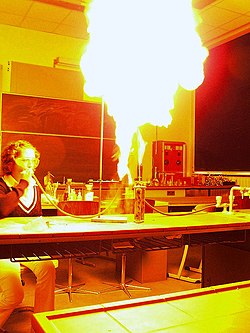Other uses
Lycopodium powder is also sometimes used as a lubricating dust on skin-contacting latex (natural rubber) goods, such as condoms and medical gloves. [4]
In physics experiments and demonstrations, lycopodium powder can be used to make sound waves in air visible for observation and measurement, and to make a pattern of electrostatic charge visible. The powder is also highly hydrophobic; if the surface of a cup of water is coated with lycopodium powder, a finger or other object inserted straight into the cup will come out dusted with the powder but remain completely dry.
Because of the very small size of its particles, lycopodium powder can be used to demonstrate Brownian motion. A microscope slide, with or without a well, is prepared with a droplet of water, and a fine dusting of lycopodium powder is applied. Then, a cover-glass can be placed over the water and spore sample in order to reduce convection in the water by evaporation. Under several hundred diameters magnification, one will see in the microscope, when well focused upon individual lycopodium particles, that the spore particles "dance" randomly. This is in response to asymmetric collisional forces applied to the macroscopic (but still quite small) powder particle by microscopic water molecules in random thermal motion. [5]
As a then-common laboratory supply, lycopodium powder was often used by inventors developing experimental prototypes. For example, Nicéphore Niépce used lycopodium powder in the fuel for one of the first internal combustion engines, the Pyréolophore, in about 1807, [6] and Chester Carlson used lycopodium powder in 1938 in his early experiments to demonstrate xerography. [7]
This page is based on this
Wikipedia article Text is available under the
CC BY-SA 4.0 license; additional terms may apply.
Images, videos and audio are available under their respective licenses.


